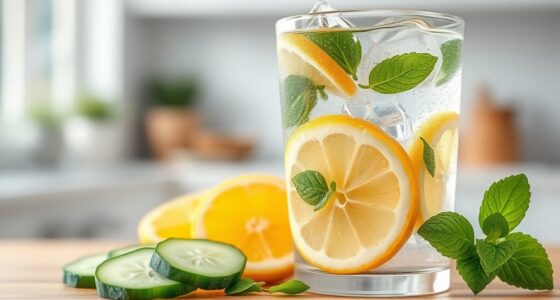If you pack acidic fruits like oranges, strawberries, or pineapple for a picnic, your teeth could suffer from enamel erosion and increased sensitivity. The acids soften enamel temporarily, making it easier to damage and causing discoloration or discomfort over time. To protect your smile, limit your intake, rinse your mouth afterward, and choose gentler snack options. Keep exploring tips to enjoy your picnic without compromising your dental health.
Key Takeaways
- Acidic fruits like oranges and strawberries can erode tooth enamel, causing sensitivity and discoloration over time.
- Moderation and pairing acidic fruits with water or cheese help minimize enamel damage during picnics.
- Rinse your mouth with water after consuming acidic foods and avoid brushing immediately to protect enamel.
- Choose low-acid fruits and tooth-friendly snacks such as nuts or cheese for healthier picnic options.
- Post-picnic dental care, including rinsing and waiting before brushing, helps maintain long-term dental health outdoors.
Understanding the Impact of Acidic Fruits on Tooth Enamel
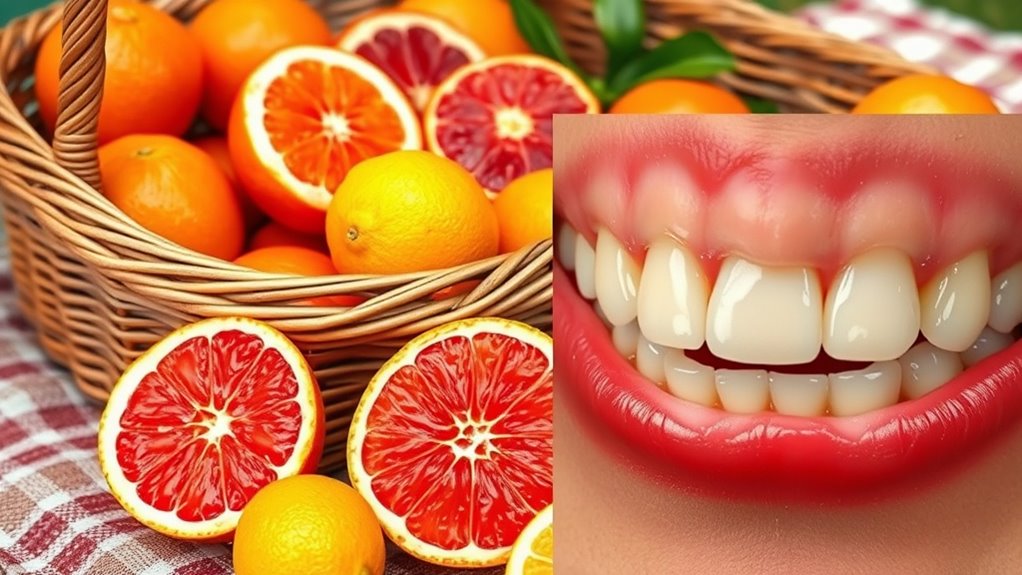
Since acidic fruits like oranges, strawberries, and pineapples are common picnic staples, it’s important to understand how they affect your tooth enamel. These fruits contain natural acids that can lead to dental erosion if consumed excessively. Acidic beverages, including fruit juices and sodas, compound this problem, increasing the risk of enamel breakdown. When you eat or drink these items, the acids temporarily soften your enamel, exposing it to potential damage from brushing or biting. Over time, frequent exposure can cause enamel thinning, tooth sensitivity, and discoloration. To protect your teeth, drink water after consuming acidic foods, avoid brushing immediately afterward, and limit your intake of these fruits and beverages during your picnic. Prevention helps maintain your smile’s health and strength. Incorporating hydrotherapy techniques, such as rinsing with water or applying moist compresses, can also soothe sensitive teeth after acidic food exposure.
Common Picnic Fruits That Can Challenge Dental Health
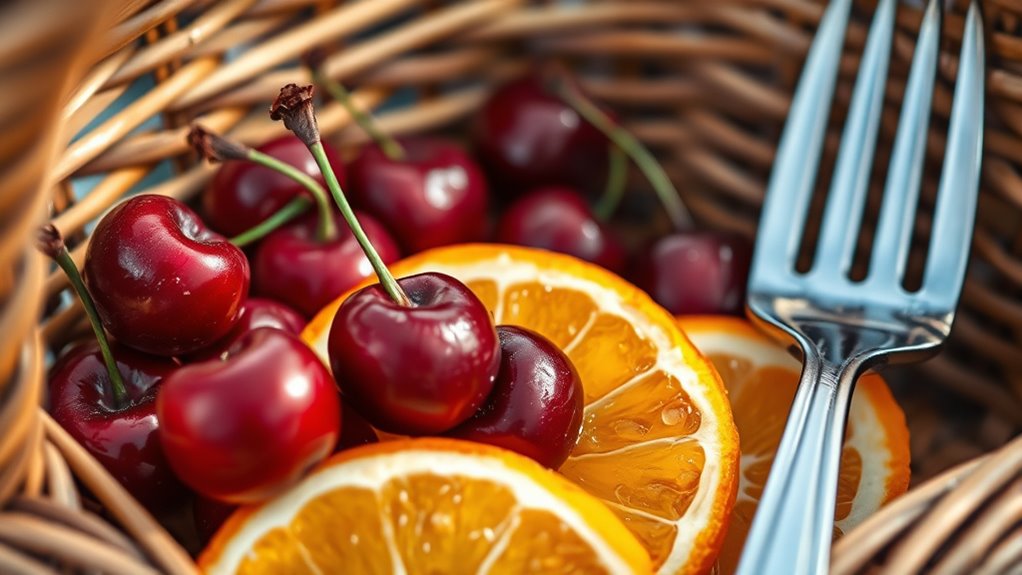
Many popular picnic fruits can pose challenges to dental health due to their high acidity and sugar content. Fruits like oranges, pineapples, and strawberries are delicious, but their acidity can erode enamel over time. While these fruits provide valuable fruit fiber, which aids digestion benefits and promotes a healthy gut, their sugar can fuel cavity-causing bacteria. Eating them in moderation helps you enjoy their benefits without risking tooth sensitivity. Incorporating high-fiber fruits like apples or pears can also support digestion benefits while being gentler on your teeth. Remember, it’s not just about what you eat but how and when you consume it. Combining these fruits with water or cheese can help neutralize acidity and protect your dental health during your picnic. Using proper oral hygiene practices after eating can further reduce the risk of dental issues caused by acidic foods.
How Acidic Fruits Contribute to Tooth Sensitivity
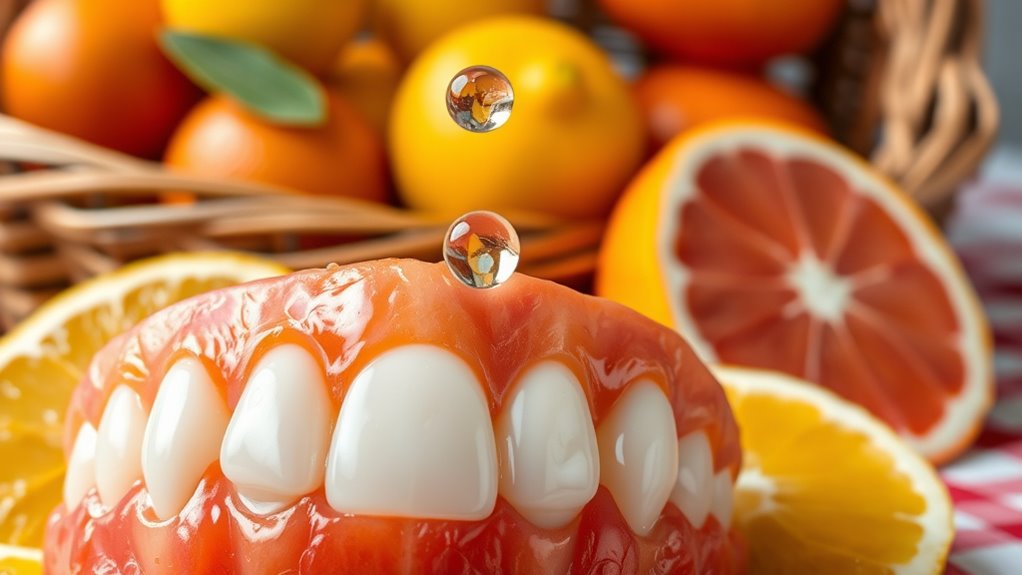
Eating acidic fruits at picnics can wear down your enamel, making your teeth more sensitive. This erosion increases the risk of discomfort when consuming hot, cold, or sweet foods. Learning simple strategies can help protect your teeth and keep your smile healthy. Using an air purifier to improve overall indoor air quality can also contribute to better oral health by reducing airborne bacteria and allergens that may affect your respiratory system.
Enamel Erosion Risks
Acidic fruits like oranges, lemons, and grapefruits can weaken your tooth enamel, making your teeth more vulnerable to sensitivity and damage. When enamel erodes, you lose the protective layer that shields your teeth from everyday wear and temperature changes. This process can lead to increased tooth sensitivity and a higher risk of cavities. Saliva buffering naturally combats acidity by neutralizing acids in your mouth, helping to slow enamel erosion. Additionally, supporting tooth remineralization can help repair minor damage by restoring minerals to weakened enamel. However, frequent consumption of acidic fruits can overwhelm these natural defenses, accelerating erosion. To protect your teeth, be mindful of how often you indulge in these fruits and maintain good oral hygiene to support your saliva’s natural buffering capacity. Understanding enamel erosion and its effects is crucial for maintaining long-term dental health.
Strategies to Minimize Damage
To minimize damage from acidic fruits, you should adopt specific strategies that protect your teeth from increased sensitivity. Start by carefully choosing how you store your fruit; keep acidic items separate from other foods to prevent cross-contamination. When packing a picnic, opt for less acidic fruits or include neutral options like bananas or melons alongside citrus or berries. Rinse your mouth with water after eating acidic fruit to wash away residual acids and reduce their contact with your enamel. Using a straw can also help direct the juice past your teeth, limiting exposure. Avoid brushing immediately after consuming acidic fruit, as the enamel may be temporarily softened. Instead, wait at least 30 minutes before brushing to prevent further erosion. Being aware of the types of fruits that are more acidic can help you make better choices for your dental health. These tips help safeguard your teeth during picnic outings.
Recognizing Signs of Enamel Erosion From Fruit Consumption
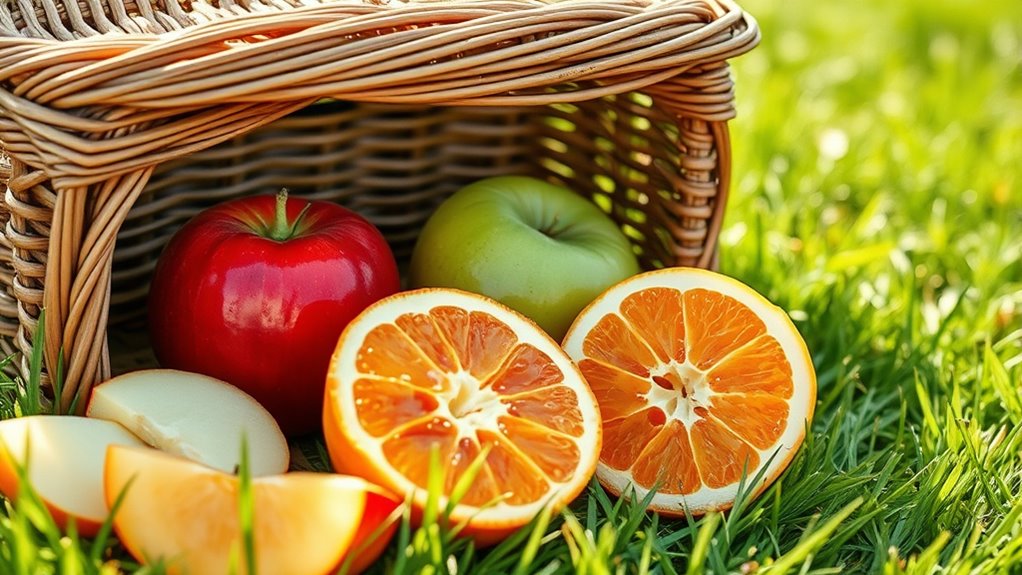
You might notice your teeth look more discolored or translucent after enjoying fruit. You could also feel increased sensitivity to hot or cold foods. Recognizing these signs early helps you protect your enamel and maintain a healthy smile. Using proper oral hygiene practices can further prevent enamel erosion caused by acidic fruit.
Visible Tooth Discoloration
When fruit consumption leads to enamel erosion, one of the most noticeable signs is visible tooth discoloration. You might notice your teeth look dull, yellowed, or stained, which can be mistaken for poor oral hygiene. Acidic fruits can wear down enamel, exposing the underlying dentin, which is naturally darker. This process often results in dental staining, making your teeth appear discolored. You may also find that tooth whitening treatments become less effective, as the enamel surface is compromised. Recognizing this discoloration early can help you seek dental advice before the damage worsens. Consuming acidic foods in moderation and practicing good oral hygiene can significantly reduce the risk of enamel erosion and discoloration. Maintaining good oral hygiene and limiting acidic fruit intake can help preserve your natural tooth color and prevent further staining or discoloration caused by enamel erosion.
Increased Tooth Sensitivity
Visible tooth discoloration from fruit-induced enamel erosion often signals deeper issues with tooth health. Increased tooth sensitivity is another warning sign you shouldn’t ignore. As enamel wears down, your teeth become more responsive to hot, cold, or sweet foods. You might notice discomfort when eating fruit or sipping beverages. Using toothpaste with proper ingredients, especially those containing fluoride, can help strengthen enamel and reduce sensitivity. Fluoride benefits include promoting remineralization and protecting against further erosion. Look for toothpaste that targets sensitivity, and avoid acidic fruits or rinse your mouth afterward to minimize damage. Recognizing these signs early allows you to take steps to preserve your enamel and prevent more serious dental issues down the line. Additionally, understanding self watering plant pots can be beneficial for maintaining healthy plants with proper moisture levels, just as managing enamel health requires careful attention.
Tips for Enjoying Fruits Safely During Your Picnic
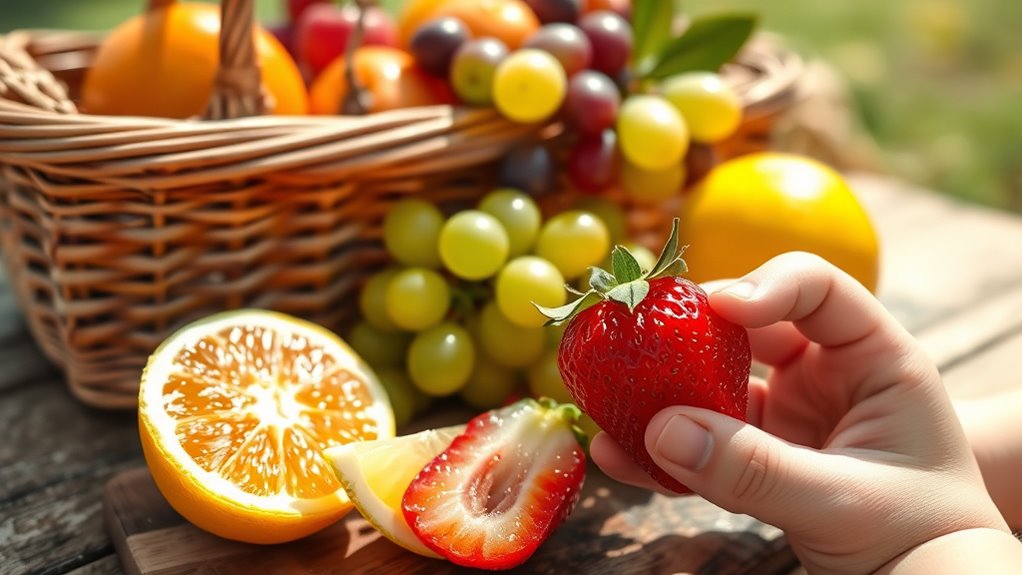
To enjoy fruits safely during your picnic, it is vital to handle and store them properly. Keep fruits chilled in a cooler or insulated bag to prevent spoilage and bacteria growth. When setting up, consider attractive fruit bowl arrangements that are easy to access and minimize mess. Incorporate colorful, bite-sized pieces into your picnic table decor to encourage moderation and make healthy choices tempting. Avoid letting cut fruits sit in the sun too long, as heat accelerates spoilage. Use airtight containers to protect fruits from insects and contamination. Wash fruits thoroughly before packing, and serve them promptly to reduce the risk of decay. Proper handling ensures you enjoy fresh, tasty fruit without compromising your health or your smile. Additionally, using specialized spray tips can help ensure your fruits are presented beautifully and safely.
Best Practices for Protecting Your Smile Outdoors
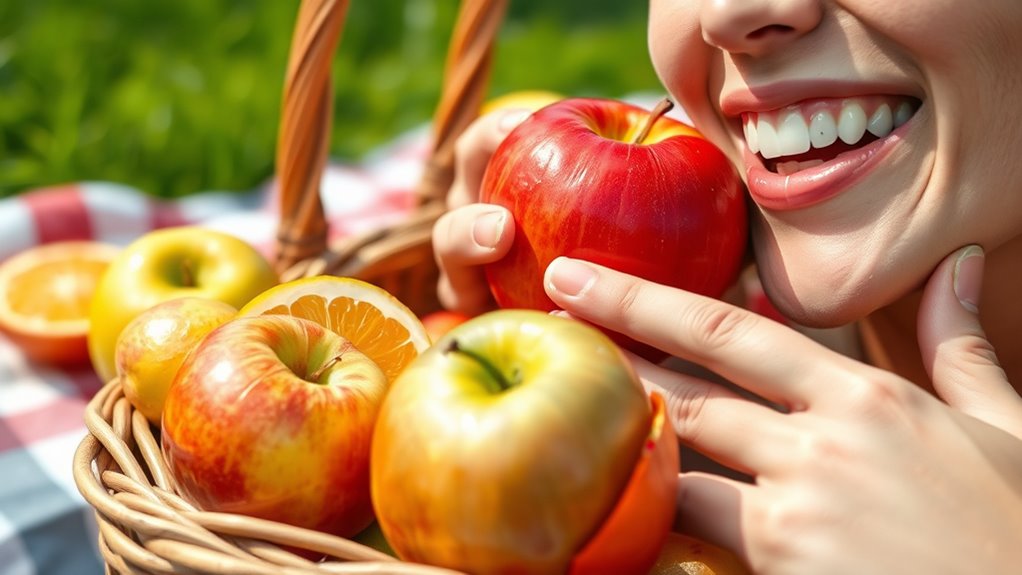
Enjoying your outdoor picnic means taking steps to protect your smile from common hazards like food debris, sugary drinks, and environmental factors. First, make sure to floss after eating to remove food particles stuck between your teeth, reducing the risk of decay and plaque buildup. If you’re participating in active outdoor sports or activities, consider wearing a mouthguard to shield your teeth from potential impacts. Staying hydrated with water helps wash away acids and sugars that can harm your enamel. Avoid biting into hard or sticky foods that could chip or damage your teeth. Additionally, be mindful of the storage of your snacks and drinks, as improper storage can lead to spoilage or increased acidity, which may harm your dental health. By staying mindful of these practices, you can enjoy your picnic without compromising your dental health. Protecting your smile outdoors is simple with good habits and a little extra care.
Alternatives to Highly Acidic Fruits for a Dental-Friendly Picnic
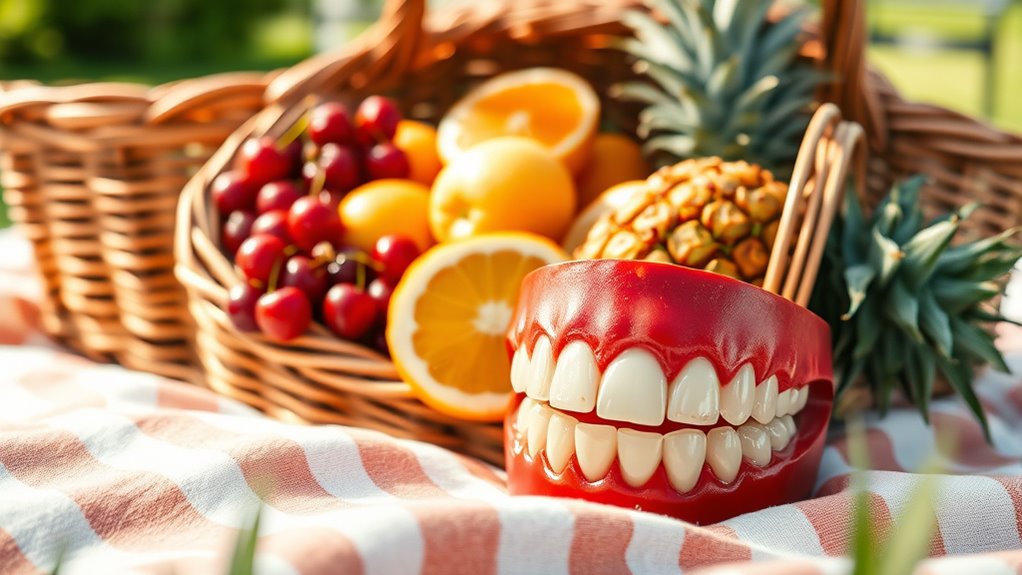
While protecting your smile outdoors is important, choosing the right snacks can make a difference. Instead of highly acidic fruits, opt for healthier snack options that are gentle on your teeth. Here are four alternatives to contemplate:
Choose tooth-friendly snacks like berries, veggies, cheese, or nuts for a healthier outdoor treat.
- Fresh berries like blueberries or strawberries (in moderation)
- Crunchy vegetables such as carrots or celery
- Unsweetened apple slices or pear slices
- Cheese cubes or nuts for added calcium and protein
These options provide fruit variety benefits without risking enamel erosion. They’re tasty, portable, and won’t contribute to acid damage. By selecting these healthier snacks, you help maintain your dental health while enjoying your picnic. Remember, variety keeps things interesting and supports overall wellness, making your outdoor snack both enjoyable and tooth-friendly.
Post-Picnic Dental Care to Prevent Damage
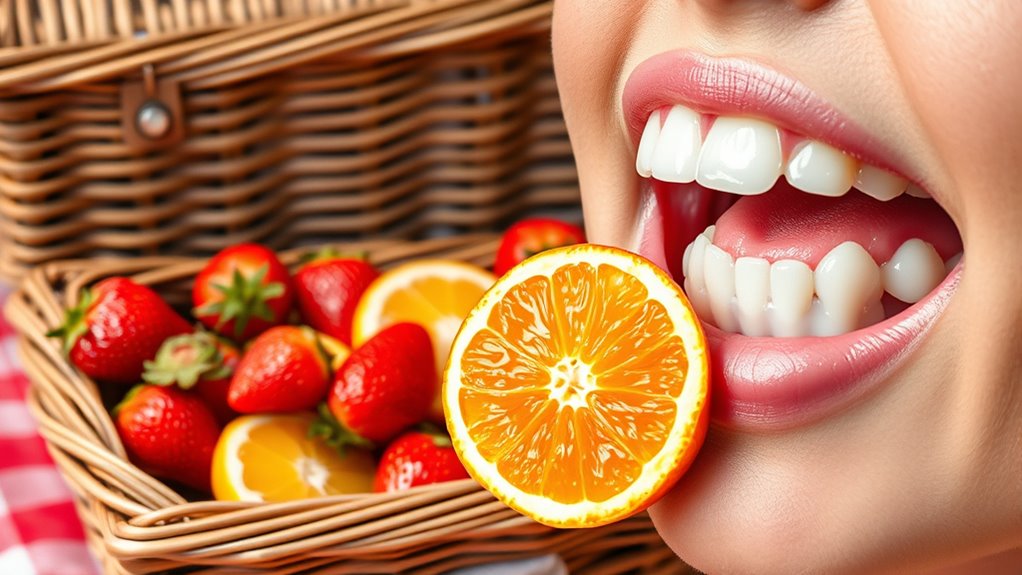
After your picnic, it’s vital to take quick steps to protect your teeth from potential damage. Rinse your mouth with water to wash away acids and sugars from fruits or snacks. Consider applying dental sealants if you’re prone to cavities; they provide a protective barrier against acids. If you’re at home, ask your dentist about fluoride treatments, which help strengthen your enamel and make teeth more resistant to acid erosion. Avoid brushing immediately after eating, as enamel can be softened; wait at least 30 minutes. Regularly using fluoride toothpaste also reinforces your enamel daily. These simple steps, including sealants and fluoride, will help minimize the risk of decay and enamel erosion caused by acidic foods, keeping your smile healthy after your outdoor feast.
Frequently Asked Questions
Are There Specific Age Groups More Vulnerable to Acidic Fruit Damage?
You might wonder if certain age groups are more vulnerable to acidic fruit damage. Kids, with their developing pediatric enamel, are more prone to erosion from acidic foods. Adults generally have stronger enamel but still need to protect their teeth to maintain good adult dental health. It’s essential to be mindful of acidity levels regardless of age, as prolonged exposure can weaken enamel and lead to dental issues over time.
Can Drinking Water Immediately After Eating Acidic Fruits Neutralize the Acid?
Drinking water immediately after eating acidic fruit can help wash away some of the acid, reducing the risk of dental erosion. Water dilutes the acids in the mouth, making it less likely for your teeth to suffer damage. However, it’s not a complete solution—wait at least 30 minutes before brushing, as acids soften enamel temporarily. Staying hydrated and practicing good oral hygiene helps protect your teeth from the effects of acidic fruit.
Do Dental Sealants Provide Protection Against Acid Erosion From Fruits?
Dental sealants do provide some protection against acid erosion from fruits, but their effectiveness is limited. Sealant effectiveness depends on proper application and maintenance. While sealants act as an acid barrier, they aren’t a foolproof solution. For best protection, combine sealant application with good oral hygiene and reducing acidic food intake. An acid barrier application, along with other preventive measures, helps keep your teeth safer from fruit-related acid damage.
How Does the Frequency of Fruit Consumption Influence Enamel Erosion Risk?
Think of your teeth as a delicate fortress under siege. When you eat fruit frequently, it’s like constant bombardment, increasing your risk of enamel erosion. The more often you indulge, the less time your enamel has to recover. So, if you want to protect your teeth, limit the frequency of fruit consumption, especially acidic varieties. Spacing out your fruit intake reduces the erosion risk and keeps your smile strong and resilient.
Are There Natural Remedies to Remineralize Enamel After Acidic Fruit Exposure?
You’re wondering if there are natural ways to help your enamel repair after acidic fruit exposure. While home remedies like rinsing with fluoride mouthwash or chewing sugar-free gum can promote saliva production, they mainly help protect your enamel. To support remineralization, eat calcium-rich foods like cheese or drink fluoridated water. Remember, consistent oral hygiene and reducing acidity in your diet are key for effective enamel repair.
Conclusion
So, next time you’re packing that picnic basket, remember: luscious, tangy fruits might make your taste buds dance but could leave your smile crying in the corner. Embrace the less acidic options, rinse wisely, and avoid turning your dental health into an unintended science experiment. Because nothing says “good times” like enjoying nature without waking up to a mouth that’s more sensitive than a soap opera plot twist. Smile bright—your teeth deserve a break.




